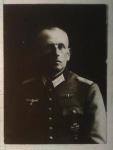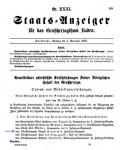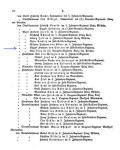-
Posts
4,908 -
Joined
-
Last visited
-
Days Won
97
Content Type
Profiles
Forums
Blogs
Gallery
Events
Store
Everything posted by Dave Danner
-
HR 15 would make sense. The only hussar regiment to receive more awards of the Mecklenburg-Schwerin MVK was RHR 6 from the 17.RD. And I believe RHR 6 was formed by HR 15. The chiefs of HR 15 until 1897 were the grand dukes of Mecklenburg-Schwerin, and after than Queen Wilhelmina of the Netherlands, whose husband was Heinrich Herzog zu Mecklenburg.
-
There are quite a few different systems for abbreviations. Here are some examples: EH - Reichswehr ranklists HSäH - Deutscher Ordens-Almanach, Handbuch für das deutsche Reich HSEH - Handbuch über den preussischen Hof und Staat HSH - Prussian Army and Reichsmarine ranklists SEH - Bavarian and Saxon ranklists SEHO - Sachsen-Meiningen Hof und Staatshandbuch Some of these systems also use different numbers or letters for the different classes, just to make it more confusing.
-
Knight 2nd Class EH1 - Grand Cross EH2a - Commander's Cross with Star EH2b - Commander's Cross EH3a - Knight's Cross 1st Class EH3b - Knight's Cross 2nd Class EH4 - Merit Cross associated with the Order "EH" for "Ernestinischer Hausorden". Some systems use "HSH" for "Herzoglich Sächsischer Hausorden".
-
On the German system: The peacetime divisions were also administrative subdivisions of the corps area, and included the cavalry brigade and the local Landwehr-Inspektion. On mobilization, the cavalry brigades were withdrawn adn the divisions became tactical formations, so the renaming made some sense. Artillery was considered a support arm, and not an arm of decision like the infantry and cavalry (and later armor). For what it's worth, the United States did not follow this pattern. World War I divisions were just "1st Division" etc. It was not until 1940, I believe, that they were officially designated as "## Infantry Division". As for why the Reserve, Landwehr and Ersatz divisions didn't have "Infanterie" in their names, I don't have an answer. Perhaps just for convenience. Since there weren't any other divisions except for Kavallerie-Divisionen, and there weren't any Reserve or Landwehr-Kavallerie division-sized formations, there wasn't any real need to designate the RD/LD/ED as "Infanterie" to know that's what they were. That wasn't always the case at brigade-level and below, where you needed to distinguish an RIR from an RFAR, for example. On the flip side, I have seen Ersatz-Infanterie-Brigade wrongly used for formations which were properly Ersatz-Brigaden or gemischte Ersatz-Brigaden. Actually, you probably know more than you realize. All the regiments were also named "Großdeutschland": Panzer-Regiment Großdeutschland, Panzer-Grenadier-Regiment Großdeutschland, Panzer-Artillerie-Regiment Großdeutschland, etc. Yes, the Soviet Army had Artillery Divisions in World War II.
-
Which son? If Bolko, then I also have some detail on him: Born 14.9.1890 in Strebitzko, Kreis Militsch; 21.6.10 in das Leib-Grenadier-Regiment Nr. 8 eingetreten, 18.11.11 Leutnant, ins Feld mit RIR 8, 18.9.15 Oberleutnant, beim Ortskommandantur v. Buja, 18.10.18 Hauptmann, 5.3.20 ausgeschieden, 1.10.37 mit Wirkung von 1.7.37 wieder angestellt als Hauptmann (E), 1.8.38 Major (E), 1.9.41 Oberstleutnant, 1.9.43 Oberst, Leiter Wehrmeldeamt Gleiwitz, Kommandeur Wehrbezirkkommando Glatz. Regards, Dave
-
What I have below. Glenn or Andy probably have more detail. Born 6.3.1859 in Strebitzko, Kreis Militsch; 1903 name change to Müller-Kranefeldt 01.10.1879 in das Ulanen-Regt. Nr. 1 eingetreten xx.xx.1894 kommandiert als Adjutant, 34. Kavallerie-Brigade 14.12.1897 z. Ulanen-Regt. Nr. 11 versetzt 20.11.1900 kommandiert als Adjutant, 9.Division 18.10.1904 zum Ulanen-Regt. Nr. 4 versetzt 01.10.1908 mit der Führung des Jäger Regiment zu Pferde Nr 5 beauftragt 20.04.1909 Kommandeur, Jäger Regiment zu Pferde Nr 5 19.02.1910 Abschied bewilligt World War I assignments: Kreischef in Belgien Distrikts-Kommandant bei der Militär-Verwaltung in Rumänien Kommandeur, Landwehr-Kavallerie-Regiment Nr. 2 Führer, Landwehr-Infanterie-Regiment Nr. ___ [i don't know which one] Promotions: 12.02.1881 Sekonde-Lieutenant 19.11.1889 Premier-Lieutenant 12.09.1894 Rittmeister 12.09.1902 Major 20.04.1909 Oberstleutnant 27.01.1915 Charakter als Oberst a.D. 14.09.1915 Patent als Oberst a.D. Decorations: Roter-Adlerorden 4.Klasse Kronenorden 3.Klasse Dienstauszeichnungskreuz Centenar-Medaille Russischer St.-Annen-Orden 3.Klasse
-
Indeed. Even the lesser known ones had other known awards. Jobst v. Hanstein. in charge of defenses in Marseilles against French forces in August 1944, was also an RK and DKiG recipient. Probably the only reason he was not a general was that he had a break in service from 1929 to 1933. But most relevant for Tom's bar is that these are all known Army officers, so they can be eliminated. By the way, Figg apparently changed his name sometime after the war. He was "Fick" in World War I. Reichswehr rank lists have him as "Dr. Figg", so he must have gotten a doctorate after the war too. I couldn't find a matching Figg in the lists of doctorates in the Jahresverzeichnis der deutschen Hochschulschriften. There were several Ficks, though I can't say for certain which one he was.
-
Tom: John Ansat - Generalleutnant in the Army Friedrich Wilhelm v. Chappuis - General der Infanterie Jobst v. Hanstein - Oberst in the Army Julian Erich Hildebrand - Generalmajor in the Army Wilhelm Keiper - Generalmajor in the Army Johannes Lentzsch - Generalleutnant z.V. in the Army Werner Marschhausen - Oberst in the Army Dietrich v. Saucken - General der Panzertruppe Johann Sinnhuber - General der Artillerie Hans v. Sommerfeld - Generalleutnant in the Army Helmuth Weidling - General der Artillerie Heinrich Wosch - Generalleutnant in the Army I don't have anything on Figg, Georg Hoogklimmer or Heinz Wrede in the Wehrmacht, although none are in the Luftwaffe Officer Career Summaries by deZeng and Stankey. There are way too many officers named Koch in the Luftwaffe to narrow that one down. Dave
-
I do not think ID'ing will be possible, though Paul's advice could generate some possibilities. The lack of Landesorden from the smaller German states makes it hard to narrow bars like this down. • First problem is, we cannot say whether he was even in the army. Many Navy officers, especially Seeflieger, ended up in the Luftwaffe. • Second, we don't know that he stayed in the Reichsheer and was in the Weimar rank lists. Police time and time as a civilian employee of the Reichswehr (Angestellter im Reichdienst gem. § 56 WVG) also counted toward the Wehrmacht DA • Third, we really can't say for certain when he entered service. An officer could have served from the early 1900s, gotten out in 1920, and returned as an E-officer in the 1930s and gotten his 18 years that way. Some Army examples, all with the WHDA2: • Oberstlt.z.D. Richard Bohnenkamp served in the Prussian Army from 1902 to 1920, retiring as a char. Major, returned to the Wehrmacht in 1935, and was placed z.D. in 1938. • Oberst Albert Bedenk was a war volunteer in August 1914, went to the police in 1920, and returned to the Wehrmacht in 1935. • Oberst Wolfgang Graf Bülow von Dennewitz served from 1905 to 1920, retiring as a char. Major, and returned to the Wehrmacht in 1934. • Generalmajor Werner von Bülow served from 1916 to 1920, and then went into the police, returning to the Wehrmacht in December 1934. • Oberst Franz Christoffer von Bülow served from 1905 to 1919, retiring as a Rittmeister, and returned to the Wehrmacht in 1935. • Oberst August Clüver served from 1900 to 1920, retiring as a char. Major, and returned to the Wehrmacht in 1934, missing out on a WHDA1 by a few months. • Oberst Werner Hoffmann served from 1904 to 1919, retiring as a char. Major, and returned to the Wehrmacht in 1936. • Oberst Johannes Jahns served from 1903 to 1919, spent two years as a Referent beim Infanterieführer VI from 1925 to 1927, and got his WHDA2 immediately after he returned to the Wehrmacht in 1936. • Oberst Gustav Klein served from 1904 to 1920, retiring as a char. Major, and returned to the Wehrmacht in 1934. • Oberst Kurt Kleindienst served from 1914 to 1925, so he actually does show up in a Reichsheer ranklist, but with 11 years of Imperial and RH service, you wouldn't know he was eligible for the WHDA2 after he returned to the Wehrmacht unless you also knew that he was a civilian Sachbearbeiter für Nachrichtenwesen in Wehrkreis I from 1927 to 1933. • Oberst Sigurd von Kleist served from 1904 to 1920, retiring as a char. Major, and returned to the Wehrmacht in 1936. • Oberst Günther Klemm was a war volunteer in August 1914, went to the police in 1920, and returned to the Wehrmacht in 1935. • Oberst Gottfried Mackensen served from 1903 to 1919, retiring as a char. Major, and returned to the Wehrmacht in 1934, first as a civilian and then as a Maj.a.D./Maj.(E). • Oberst Rudolf Mackensen von Astfeld served from 1903 to 1920, retiring as a char. Major, and returned to the Wehrmacht in 1935. That's just a sample, but large enough to show that the number of higher-ranking and well-decorated Wehrmacht officers missing from the interwar rank lists is pretty high.
-
Don, Here: http://des.genealogy.net/eingabe-verlustlisten/search/index There are some glitches, and it doesn't do search variants, so you have to get the name right. Main page for the project is here: http://wiki-de.genealogy.net/Verlustlisten_Erster_Weltkrieg/Projekt They are also only about 70% complete in transcribing the lists (though that is a huge accomplishment in itself).
-
Swords are not incorrect. They were authorized late in the war. They should be silver for the medal, though. There is no way to tell whether it is the medal or the cross, though, since incorrect swords are a common thing. For that matter, there is no way to tell whether it is the Saxon DA for NCOs and enlisted men or the Saxon LD2. Since Saxony was comparatively liberal with war awards, the lack of a Saxon war decoration makes me think the holder was an ex-Saxon who served in the Prussian Army in World War I. A native of one of the two Schwarzburgs, or serving in a Schwarzburg contingent.
-
Eduard (von) Kraus Ritterkreuz on 26.10.1870 as Oberstleutnant, 6. Infanterie-Regiment Commandeurkreuz on 4.3.1871 as interim commander, 3. Infanterie-Regiment Commandeurkreuz mit Stern in 1875 as Generalmajor z.D. August Freiherr von Stetten Ritterkreuz on 4.3.1871 as Major, Feldartillerie-Regiment http://gmic.co.uk/uploads/monthly_10_2013/post-432-0-99151200-1382847204.jpghttp://gmic.co.uk/uploads/monthly_10_2013/post-432-0-60929700-1382847212.jpg
-
Some additional information; 1) Sekretär Hillenbrand That should be Veterinär Hillerbrand: Norbert Hillerbrand, *26.11.1883 in Haag, Obb. 2) Rendant Schnabl Johann Schnabl, *3.2.1867 in Waldmünchen, Zahlm. in 4.ChevR, 1917 Rendant 3) Feldw. Ltn. Obermeier Josef Obermeier, *10..12.1867 in Mühlhausen, Mallersdorf 7) Regts. Sattler Fahres Georg Fahres, *24.7.1868 in Hofheim 13) Major v. Regemann ?Kdr.? des Ers. Depots 4. Chev. Regts. Hugo v. Regemann, *14.5.1872 in Augsburg, Maj.d.R.a.D., Kdr. of the Ers.Depot from 1.11.16 14) Uzm. Herhammer I think that's Vzw. for Vizewachtmeister. Regards, Dave












